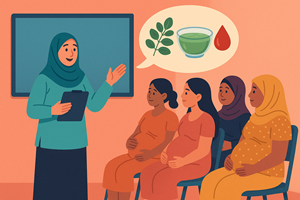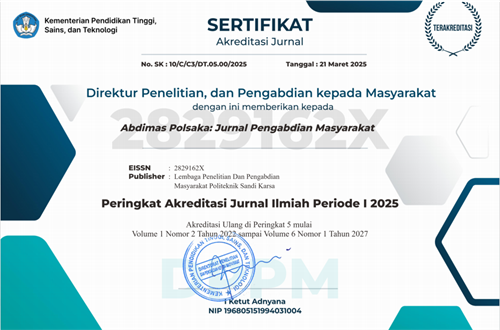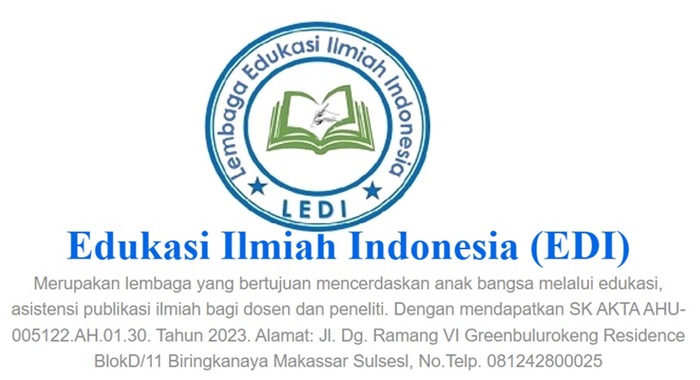Socialization of making moringa pudding to increase HB levels for pregnant women with anemia
DOI:
https://doi.org/10.35816/abdimaspolsaka.v4i2.106Keywords:
Anemia, Health Education, Hemoglobin, educational status, Moringa Pudding, Pregnant WomenAbstract
Anemia remains a significant public health concern among pregnant women, with increased risks of complications during pregnancy, low birth weight, and maternal mortality. Pregnant women require twice as much iron as non-pregnant women, making adequate iron intake essential. Moringa (Moringa oleifera) leaves, rich in iron and essential nutrients, can potentially improve haemoglobin (Hb) levels. This community service program aimed to provide education on the benefits of moringa leaves and to demonstrate the preparation of nutrient-rich moringa pudding as a healthy, locally sourced alternative to prevent anaemia in pregnant women. The activity was conducted at Pattingaloang Public Health Center, involving 13 pregnant women. The implementation included lectures, leaflets, discussions, and demonstrations of moringa pudding preparation. Pre- and post-tests were used to measure participants’ knowledge. Results showed an increase in the proportion of participants with good knowledge from 77% before the intervention to 100% afterward. The active participation and enthusiasm of the attendees indicated high acceptance of the intervention. This initiative successfully improved knowledge and skills in utilizing moringa leaves for nutritional enhancement during pregnancy. It also encouraged community empowerment by promoting local food processing innovations. Sustained implementation of such programs has the potential to reduce anemia prevalence and improve maternal health outcomes.
Downloads
References
[M. Abdulsalam, M. Tessema, M. Mohsin, T. Malik, and F. I. Abdulsalam, “Determining factors associated with anaemia in pregnant women visiting the antenatal care unit at St. Paul’s Hospital, Addis Ababa, Ethiopia: Unmatched case-control study,” Women Child. Nurs., vol. 3, no. 1, pp. 27–34, Mar. 2025, doi: https://doi.org/10.1016/j.wcn.2025.02.001.
B. B. Afolabi et al., “Intravenous versus oral iron for anaemia among pregnant women in Nigeria (IVON): an open-label, randomised controlled trial,” Lancet Glob. Heal., vol. 12, no. 10, pp. e1649–e1659, 2024, doi: https://doi.org/10.1016/S2214-109X(24)00239-0.
I. Angeles-Agdeppa et al., “Drivers of anemia reduction among women of reproductive age in the Philippines: a country case study,” Am. J. Clin. Nutr., vol. 121, pp. S57–S67, 2025, doi: https://doi.org/10.1016/j.ajcnut.2024.06.005.
K. Ahmed, F. S. Parveen, and N. K. Inamdar, “Effect of Unani formulation on iron deficiency anemia in women of reproductive age: A prospective randomized controlled trial,” Clin. Tradit. Med. Pharmacol., vol. 6, no. 3, p. 200224, 2025, doi: https://doi.org/10.1016/j.ctmp.2025.200224.
A. Banerjee et al., “Efficacy of daily versus intermittent oral iron supplementation for prevention of anaemia among pregnant women: a systematic review and meta-analysis,” eClinicalMedicine, vol. 74, p. 102742, 2024, doi: https://doi.org/10.1016/j.eclinm.2024.102742.
E. T. Burayu and B. D. Degefa, “Exploration of iron deficiency anemia and its associated factors among pregnant women seeking antenatal care in public health facilities of southwestern Ethiopia. A mixed study,” AJOG Glob. Reports, vol. 4, no. 4, p. 100417, 2024, doi: https://doi.org/10.1016/j.xagr.2024.100417.
J. L. Burns, C. H. Miller, B. Fontaine-Bisson, and K. L. Connor, “Iron deficiency and iron deficiency anaemia in women of reproductive age: Sex- and gender-based risk factors and inequities,” J. Trace Elem. Med. Biol., vol. 90, p. 127684, 2025, doi: https://doi.org/10.1016/j.jtemb.2025.127684.
Y. Deng et al., “Association of household air pollution exposure and anemia among pregnant women: Analysis of baseline data from ’Household Air Pollution Intervention Network (HAPIN)’ trial,” Environ. Int., vol. 190, p. 108815, 2024, doi: https://doi.org/10.1016/j.envint.2024.108815.
A. A. El-Kholy et al., “Prevalence and associated factors of anemia among pregnant women and the impact of clinical pharmacist counseling on their awareness level: A cross sectional study,” Saudi Pharm. J., vol. 31, no. 8, p. 101699, 2023, doi: https://doi.org/10.1016/j.jsps.2023.101699.
C. P. Ezenweke, I. A. Adeniyi, W. B. Yahya, and R. E. Onoja, “Determinants and spatial patterns of anaemia and haemoglobin concentration among pregnant women in Nigeria using structured additive regression models,” Spat. Spatiotemporal. Epidemiol., vol. 45, p. 100578, 2023, doi: https://doi.org/10.1016/j.sste.2023.100578.
N. C. de Freitas-Costa et al., “Hemoglobin Concentrations and Prevalence of Anemia During Pregnancy: Results from the Brazilian Maternal and Child Nutrition Consortium,” Curr. Dev. Nutr., vol. 9, no. 6, p. 107458, 2025, doi: https://doi.org/10.1016/j.cdnut.2025.107458.
H. Herlianty, A. Abdullah, E. Sri Dahrianti, and N. Ketut Sumidawati, “Impact of reproductive health education on adolescents’ self-efficacy in maintaining reproductive health,” J. Pengabdi. Masy. Edukasi Indones., vol. 2, no. 2, pp. 70–77, May 2025, doi: https://doi.org/10.61099/jpmei.v2i2.78.
K. Jayaprakash Shetty, S. Nanjesh Kumar, and K. Shrisharath, “Validation of RDT kit for screening anaemia among women of reproductive age at the field level in comparison with the gold standard in rural areas of coastal Karnataka, India,” Clin. Epidemiol. Glob. Heal., vol. 34, p. 102077, 2025, doi: https://doi.org/10.1016/j.cegh.2025.102077.
F. Junita, P. K. Wati, and R. Ulfah, “Nutritional Status with the Incidence of Anemia in Students of LSPR Jakarta Institute of Communication and Business,” J. Ilm. Kesehat. Sandi Husada, vol. 12, no. 2, pp. 288–294, 2023, doi: https://dx.doi.org/10.35816/jiskh.v12i2.994.
R. B. Kajjura et al., “Drivers of anemia reduction among women of reproductive age in Uganda: a country case study,” Am. J. Clin. Nutr., vol. 121, pp. S36–S45, 2025, doi: https://doi.org/10.1016/j.ajcnut.2024.06.015.
W. Litaqia and T. Cahya Mulat, “The impact of anemia on pregnant women on premature labor and low birth weight,” J. Edukasi Ilm. Kesehat., vol. 3, no. 1, pp. 32–38, Mar. 2025, doi: https://dx.doi.org/10.61099/junedik.v3i1.72.
N. F. Ndiaye et al., “Drivers of anemia reduction among women of reproductive age in Senegal: a country case study,” Am. J. Clin. Nutr., vol. 121, pp. S8–S21, 2025, doi: https://doi.org/10.1016/j.ajcnut.2024.05.031.
A. Owais et al., “Drivers of anemia reduction among women of reproductive age in Pakistan: a mixed-methods country case study,” Am. J. Clin. Nutr., vol. 121, pp. S46–S56, 2025, doi: https://doi.org/10.1016/j.ajcnut.2024.04.037.
A.-C. Pecher, S. Bach, J. Pauluschke-Fröhlich, H. Abele, J. Henes, and M. Henes, “Anemia and iron deficiency in pregnant women with rheumatic diseases,” Jt. Bone Spine, vol. 91, no. 1, p. 105650, 2024, doi: https://doi.org/10.1016/j.jbspin.2023.105650.
S. Suprapto, D. Arda, Y. Tri Wijayanti, and M. K. Fredy Saputra, “Providing education for the community to improve nutrition for toddlers,” Abdimas Polsaka, vol. 4, no. 1, pp. 22–29, Mar. 2025, doi: https://doi.org/10.35816/abdimaspolsaka.v4i1.40.
G. Saw, J. Van Buskirk, S. Dey, N. Singh, and L. D. Knibbs, “Association between residential greenspace and anaemia prevalence among Indian women of reproductive age,” Environ. Res., vol. 282, p. 121985, 2025, doi: https://doi.org/10.1016/j.envres.2025.121985.
J. Zhou et al., “Thalassemia genetic screening of pregnant women with anemia in Northern China through comprehensive analysis of thalassemia alleles (CATSA),” Clin. Chim. Acta, vol. 569, p. 120151, 2025, doi: https://doi.org/10.1016/j.cca.2025.120151.
K. Thakker, S. Mohanapu, and M. Sen, “A comparative study to assess Hba1c levels in antenatal non diabetic women with anemia and without anemia,” Clin. Epidemiol. Glob. Heal., vol. 30, p. 101777, 2024, doi: https://doi.org/10.1016/j.cegh.2024.101777.
J. Yang et al., “Prevalence and influencing factors of anaemia among pregnant women in rural areas of Northwestern China,” Public Health, vol. 220, pp. 50–56, 2023, doi: https://doi.org/10.1016/j.puhe.2023.04.024.
L. A. Wijayanti and S. E. Nurseskasatmata, “The Relationship between nutritional status and menstrual cycle and anemia,” J. Ilm. Kesehat. Sandi Husada, vol. 13, no. 2, pp. 306–314, Dec. 2024, doi: https://dx.doi.org/10.35816/jiskh.v13i2.1217

Additional Files
Published
How to Cite
Issue
Section
License
Copyright (c) 2025 Hasnita Hasnita, Uliarta Marbun, Irnawati Irnawati

This work is licensed under a Creative Commons Attribution 4.0 International License.
Most read articles by the same author(s)
- Uliarta Marbun, Irnawati Irnawati, Edukasi Bahaya dan Pencegahan Preeklampsia Pada Kehamilan , Abdimas Polsaka: Vol. 2 No. 1 (2023): Abdimas Polsaka: Jurnal Pengabdian Masyarakat
- Irnawati Irnawati, Uliarta Marbun, Edukasi Keluarga dalam Penentuan Penerapan Posisi Persalinan yang Menguntungkan Pada Ibu Bersalin , Abdimas Polsaka: Vol. 1 No. 2 (2022): Abdimas Polsaka: Jurnal Pengabdian Masyarakat
- Uliarta Marbun, Optimalisasi Pengetahuan Gizi Seimbang Pada Wanita Usia Subur Untuk Persiapan Persalinan , Abdimas Polsaka: Vol. 1 No. 1 (2022): Abdimas Polsaka: Jurnal Pengabdian Masyarakat
- Hasnita Hasnita, Pencegahan dan Deteksi Dini Stunting Pada Balita , Abdimas Polsaka: Vol. 1 No. 2 (2022): Abdimas Polsaka: Jurnal Pengabdian Masyarakat
- Uliarta Marbun, Irnawati Irnawati, Psychological Readiness Education and Preparation Before Childbirth , Abdimas Polsaka: Vol. 2 No. 2 (2023): Abdimas Polsaka: Jurnal Pengabdian Masyarakat
- Irnawati Irnawati, Uliarta Marbun, Hasnita Hasnita, Importance of the role of mothers in stunting prevention efforts , Abdimas Polsaka: Vol. 4 No. 2 (2025): Abdimas Polsaka: Jurnal Pengabdian Masyarakat
- Uliarta Marbun, Irnawati Irnawati, Hasnita Hasnita, Empowering couples of childbearing age to become active family planning acceptors to create quality families , Abdimas Polsaka: Vol. 4 No. 2 (2025): Abdimas Polsaka: Jurnal Pengabdian Masyarakat




















